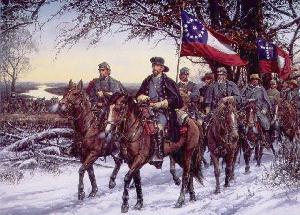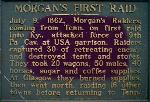|
|
|
|
At this site, Confederate Colonel John Hunt Morgan began his famous "First Kentucky Raid" with his first objective being the destruction of the Union force in and around Tompkinsville. Riding through the night, Morgan and his Raiders left Celina, Tennessee on July 8th crossed the Cumberland River and surprised the Union Forces on the early morning hours of July 9, 1862.
After the battle, Morgan's Raiders marched northward through Kentucky. In twenty-four days, Morgan and his raiders traveled over one thousand miles, captured seventeen towns, destroyed all of the government supplies and arms in them, and paroled nearly twelve hundred Union troops. Months later he again returned to Tompkinsville as a brigadier general. This time he and his raiders were only camping here as they began their next Kentucky raid "The Christmas Raid, 1862-1863."
|
|
|
| 6 - McMillan's Landing
|
| 7 - Battle of Tompkinsville |
|
|
|
|
|
|
The Christmas Raid
22nd of December, 1862
Courthouse burned in Tompkinsville
22nd of April, 1863
|
|
|
|
|
|
|



